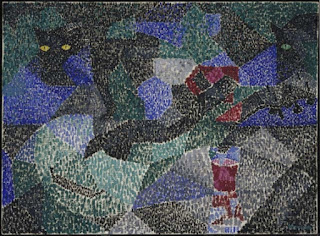Otto Gross - the maverick psychoanalyst and utopian anarchist whom radicals and exponents of free love continue to revere - died 100 years ago today: from pneumonia; aged 42; in a Berlin hospital, having been found lying in the street, starving, penniless, and half-frozen to death.
A sad and premature (arguably all-too-predictable) end to the life of a charismatic drug-addict who spent much of his adult life in and out of psychiatric institutions and who rejected all caution and restraint; a man who was even evicted from the community of bohemians at Ascona for trying to instigate orgies at which participants could openly explore their bisexual desires. [1]
Inspired by his readings of Max Stirner, Nietzsche and Kropotkin, it's said that Gross influenced in turn many artists and writers with his neo-pagan (and proto-feminist) attempt to revalue all values, including D. H. Lawrence - which, of course, is where my interest in him comes from, rather than his relationship to Freud and Jung, who basically thought him a hopeless madman about whom the less said the better.
Lawrence, of course, never met Gross and doesn't directly refer to him in his writings. [2] But his wife, Frieda, had had an affair with the latter in 1908 (at the same time that Gross was also involved with Frieda's sister, Else) and so a lot of his revolutionary ideas to do with politics, culture, the unconscious and human sexuality, were transmitted via her. It's almost certain that Lawrence also read Gross's letters to Frieda (which she treasured throughout her life):
"They affirmed the idea of the saving sexual relationship outside the bonds of society: they stressed how a sexually liberated woman could escape the trammels of the ordinary and be an inspiration for intellectual and striving men; they showed a passionately thinking man struggling to come to terms with the new and to escape the past. In many ways, they offered Lawrence the themes for his next eight years of writing; and (above all) they offered a way of thinking about Frieda [whom Gross regarded as the woman of the future]." [3]
Having said that, it's important to stress that Lawrence would have mistrusted (and disliked) Gross in person and to note that he soon saw through his idealism - including his sexual and political idealism.
And for us, living here in 2020, does Gross's thinking still trouble, still challenge? Or does it only bore and depress? Unfortunately, that's a question that some also ask of Lawrence ...
Notes
[1] Perhaps more interesting from a thanatological perspective, is the fact that Gross affirmed the sovereign freedom of the individual not merely in sexual terms, but also as the right to be ill and to die in a manner (and at a time) of their own choosing. He regarded neurosis and suicide as legitimate expressions of protest against a repressive social order.
[2] Lawrence gives us a fictionalised representation of Otto Gross in his unfinished novel Mr Noon (written 1921-22); the character of Eberhard appears in Part II of the work.
[3] John Worthen, D. H. Lawrence: The Early Years 1885-1912 (Cambridge University Press, 1991), pp. 443-44.
See also: John Turner, Cornelia Rumpf-Worthen and Ruth Jenkins, 'The Otto Gross - Frieda Weekley Correspondence: Transcribed, Translated, and Annotated', in The D. H. Lawrence Review, Vol. 22, No. 2, (Summer, 1990), pp. 137-227. Click here to read online.
[2] Lawrence gives us a fictionalised representation of Otto Gross in his unfinished novel Mr Noon (written 1921-22); the character of Eberhard appears in Part II of the work.
[3] John Worthen, D. H. Lawrence: The Early Years 1885-1912 (Cambridge University Press, 1991), pp. 443-44.
See also: John Turner, Cornelia Rumpf-Worthen and Ruth Jenkins, 'The Otto Gross - Frieda Weekley Correspondence: Transcribed, Translated, and Annotated', in The D. H. Lawrence Review, Vol. 22, No. 2, (Summer, 1990), pp. 137-227. Click here to read online.












